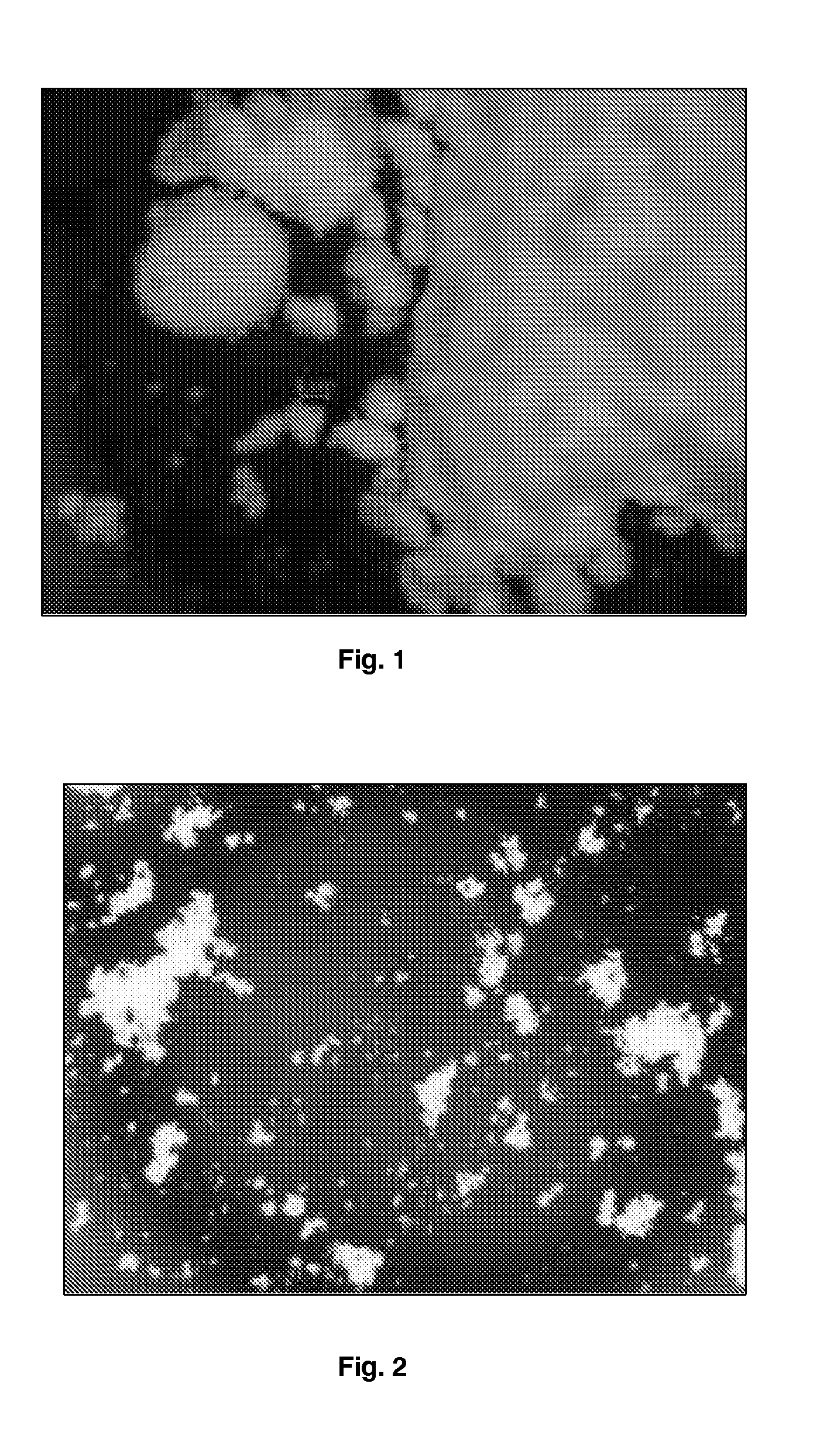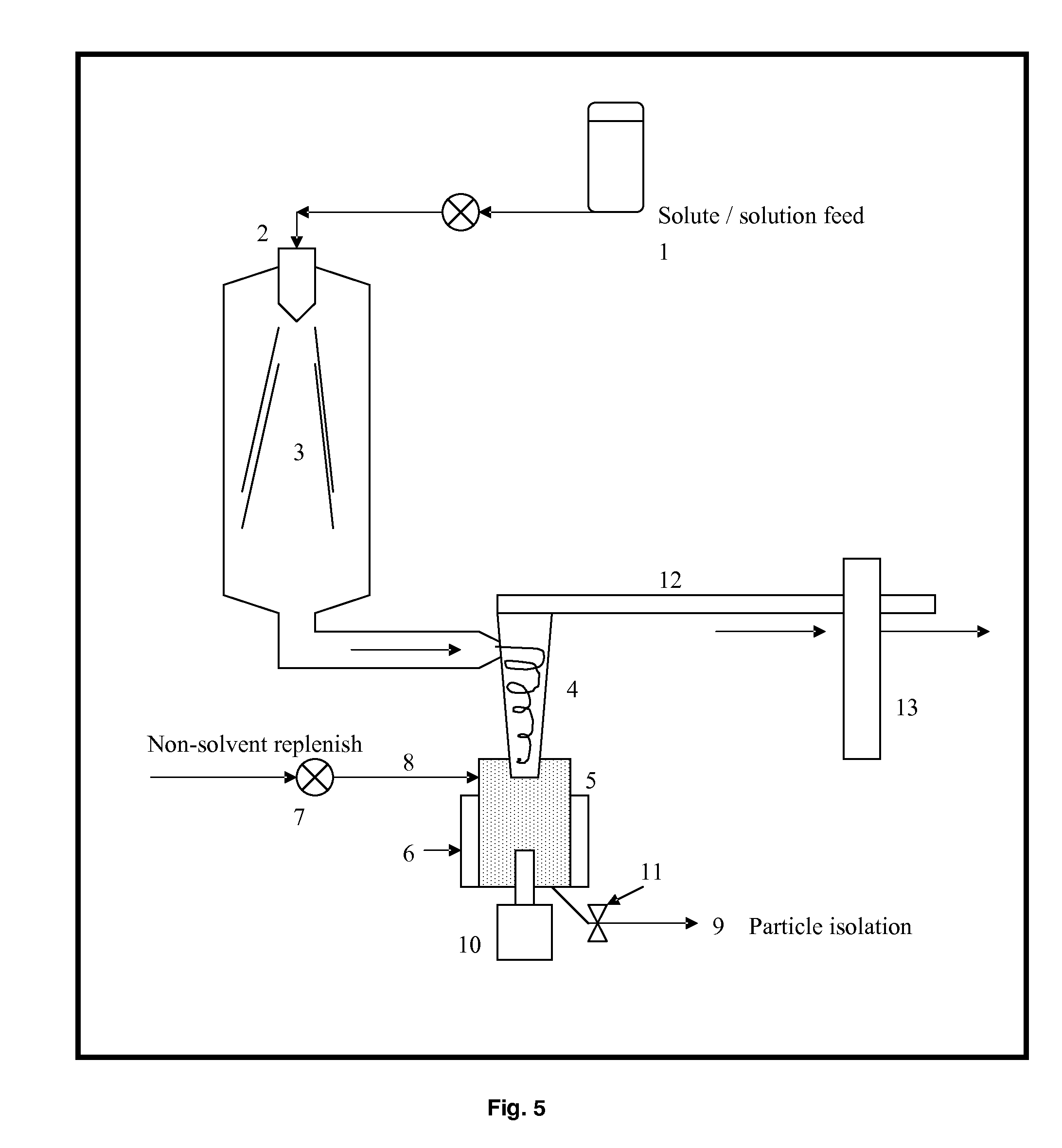Process for improving crystallinity
a crystallinity and crystallinity technology, applied in the direction of vibration crystallization, powder delivery, dispersion delivery, etc., can solve the problems of affecting the material properties of milled particles, forming amorphous structures unsuitable for end-use applications, and a significant proportion of particles, so as to reduce the amount of agglomerated particulate materials, increase the crystallinity of solid materials, and high crystallinity. stable
- Summary
- Abstract
- Description
- Claims
- Application Information
AI Technical Summary
Benefits of technology
Problems solved by technology
Method used
Image
Examples
example 1
[0211]Budesonide (5 g) was dissolved in 100 mL of dichloromethane. The samples of budesonide powder collected in the ultrasonic chamber were produced using a Büchi-290 laboratory-scale spray dryer (insulins), Büchi, Switzerland). The solution was atomized using nitrogen at 7 bar flowing at approximately at 10 Lpm (Litre / minute). The aspirator was set at 100% and flow rate of solution was set to 10 Lpm. The gas temperature was set to 120° C. Budesonide particles were collected the ultrasonic chamber connected to the end of high performance cyclone separator. In order to apply ultrasound to the spray dried particles, the collection ultrasonic chamber was filled with heptane thermoregulated at 25° C. and was fitted with an ultrasonic probe resonating at 20 kHz. Ultrasound at 20 W power was applied between 30 minutes and 1 hour. The resulting particle slurry was spray dried and particles characterized by optical microscopy and DSC (Differential Scanning calorimetry). The size of the par...
example 2
[0228]Example 2 shows the advantages of the particles produced according to the present invention.
[0229]The aerosolisation efficiency of three batches of engineered fluticasone propionate (FP) produced by various processing was assessed in binary dry powder inhaler (DPI) formulations. Batches studied include:
[0230]Sample 2 Prepared by aerosolistion method exemplied in this invention as shown in SEM FIG. 9. Fluticasone propionate (4 g) was dissolved in 100 mL of acetone. The samples of Fluticasone propionate powder collected in the ultrasonic chamber were produced using a Büchi-290 laboratory-scale spray dryer (Büchi, Switzerland). The solution was atomized using nitrogen at 7 bar flowing at approximately at 10 Lpm (Litre / minute). The aspirator was set at 100% and flow rate of solution was set to 10 Lpm. The gas temperature was set to 120° C. Fluticasone propionate particles were collected the ultrasonic chamber connected to the end of high performance cyclone separator. In order to ...
example 3
[0245]Example 3 shows the advantages of the particles produced according to the present invention for formulation in a pMDI. FIG. 25 is a particle fraction distribution graph for various stages on the NGI and clearly shows the superior performance in terms of FPF for sample 1 and sample 5. Both samples were produced in a similar manner to sample 2 of Example 2. Sample 1 was prepared from atomization of a 3% solution of fluticasone propionate in 20% dichloromethane in methanol (3 g in 100 ml) and Sample 5 was prepared from atomization of 3% solution in acetone (3 g in 100 ml). As shown in FIG. 25, the FPF on stage 5 (cut-off 1.36 μm) of the NGI for both samples showed over 100% increase compared with micronized material, alongside similar FPF for stage 4 (cut-off 2.30 μm). The FPF values were 11.80% and 13.80% on stage 5 for samples 5 and 1 respectively compared with 6.20% for micronized material. It is clear therefore, that samples 1 and 5 have a similar FPF to the micronized produc...
PUM
| Property | Measurement | Unit |
|---|---|---|
| mean median aerodynamic diameter | aaaaa | aaaaa |
| diameter | aaaaa | aaaaa |
| diameter | aaaaa | aaaaa |
Abstract
Description
Claims
Application Information
 Login to View More
Login to View More - R&D
- Intellectual Property
- Life Sciences
- Materials
- Tech Scout
- Unparalleled Data Quality
- Higher Quality Content
- 60% Fewer Hallucinations
Browse by: Latest US Patents, China's latest patents, Technical Efficacy Thesaurus, Application Domain, Technology Topic, Popular Technical Reports.
© 2025 PatSnap. All rights reserved.Legal|Privacy policy|Modern Slavery Act Transparency Statement|Sitemap|About US| Contact US: help@patsnap.com



